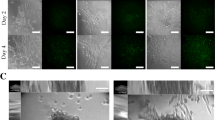Abstract
During the metastatic process, carcinoma cells form invadopodia, F-actin enriched protrusive structures, to degrade the extracellular matrix (ECM) in order to invade the surrounding stroma and intravasate into the circulatory system. In this chapter, we describe the 2D-fluorescent matrix degradation assay, a highly sensitive and reproducible in vitro method used to measure invadopodia-mediated ECM degradation. We provide a detailed protocol on how to prepare the glass coverslips with fluorescent gelatin matrix and a standardized method to quantify gelatin degradation and invadopodia formation in order to evaluate cell invasion.
Access this chapter
Tax calculation will be finalised at checkout
Purchases are for personal use only
Similar content being viewed by others
References
Lambert AW, Pattabiraman DR, Weinberg RA (2017) Emerging biological principles of metastasis. Cell 168(4):670–691
Fontana R, Vivo M (2018) Dynamics of p14ARF and focal adhesion kinase-mediated autophagy in cancer. Cancers (Basel) 10(7):221
Linder S (2007) The matrix corroded: podosomes and invadopodia in extracellular matrix degradation. Trends Cell Biol 17(3):107–117
Vivo M, Fontana R et al (2017) p14ARF interacts with the focal adhesion kinase and protects cells from anoikis. Oncogene 36(34):4913–4928
Furmaniak-Kazmierczak E, Crawley SW et al (2007) Formation of extracellular matrix-digesting invadopodia by primary aortic smooth muscle cells. Circ Res 100(9):1328–1336
Abram CL, Seals DF et al (2003) The adaptor protein fish associates with members of the ADAMs family and localizes to podosomes of Src-transformed cells. J Biol Chem 278(19):16844–16851
Fontana R, Ranieri M et al (2019) Dual role of the alternative reading frame ARF protein in cancer. Biomolecules 9(3):87
Monsky WL, Lin CY et al (1994) A potential marker protease of invasiveness, seprase, is localized on invadopodia of human malignant melanoma cells. Cancer Res 54(21):5702–5710
Ghersi G, Dong H et al (2002) Regulation of fibroblast migration on collagenous matrix by a cell surface peptidase complex. J Biol Chem 277(32):29231–29241
Paz H, Pathak N, Yang J (2014) Invading one step at a time: the role of invadopodia in tumor metastasis. Oncogene 33(33):4193–4202
Mueller SC, Artym VV, Kelly T (2008) Invadopodia: interface for invasion. In: Edwards D, Høyer-Hansen G, Blasi F, Sloane BF (eds) The cancer Degradome. Springer, New York, NY, pp 403–431
Eckert MA, Lwin TM et al (2011) Twist1-induced invadopodia formation promotes tumor metastasis. Cancer Cell 19(3):372–386
Eddy RJ, Weidmann MD et al (2017) Tumor cell invadopodia: invasive protrusions that orchestrate metastasis. Trends Cell Biol 27(8):595–607
Hendrix MJ, Seftor EA et al (1989) Comparison of tumor cell invasion assays: human amnion versus reconstituted basement membrane barriers. Invasion Metastasis 9(5):278–297
Le MN, Bruyneel E (1996) Comparison of in vitro invasiveness of human breast carcinoma in early or late stage with their malignancy in vivo. Anticancer Res 16(5A):2767–2772
Waller CA, Braun M, Schirrmacher V (1986) Quantitative analysis of cancer invasion in vitro: comparison of two new assays and of turnout sublines with different metastatic capacity. Clin Exp Metastasis 4(2):73–89
Abramoff MD, Magalhaes PJ, Ram SJ (2004) Image processing with ImageJ. Biophoton Int 11(7):36–42
Heit B (2017) Phagocyte Biology Wiki. http://129.100.26.202/index.php?title=Acid_Washing_Coverslips&oldid=119. Accessed 1 July 2020
Creed SJ, Le CP et al (2015) β2-adrenoceptor signaling regulates invadopodia formation to enhance tumor cell invasion. Breast Cancer Res 17(1):145
Ayala I, Baldassarre M et al (2008) Multiple regulatory inputs converge on cortactin to control invadopodia biogenesis and extracellular matrix degradation. J Cell Sci 121(Pt 3):369–378
Seals DF, Azucena EF et al (2005) The adaptor protein Tks5/fish is required for podosome formation and function, and for the protease-driven invasion of cancer cells. Cancer Cell 7(2):155–165
Acknowledgments
This work was supported by an American-Italian Cancer Foundation Post-Doctoral Research Fellowship to R.F. and grants from NCI (1R01CA174869, 1R01CA206880, and 1R01CA236386) and California Tobacco-Related Disease Research Program (TRDRP-587107) to J.Y.
Author information
Authors and Affiliations
Corresponding author
Editor information
Editors and Affiliations
Rights and permissions
Copyright information
© 2021 Springer Science+Business Media, LLC, part of Springer Nature
About this protocol
Cite this protocol
Fontana, R., Yang, J. (2021). Matrix Degradation Assay to Measure the Ability of Tumor Cells to Degrade Extracellular Matrix. In: Stein, U.S. (eds) Metastasis. Methods in Molecular Biology, vol 2294. Humana, New York, NY. https://doi.org/10.1007/978-1-0716-1350-4_11
Download citation
DOI: https://doi.org/10.1007/978-1-0716-1350-4_11
Published:
Publisher Name: Humana, New York, NY
Print ISBN: 978-1-0716-1349-8
Online ISBN: 978-1-0716-1350-4
eBook Packages: Springer Protocols




